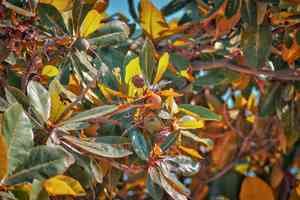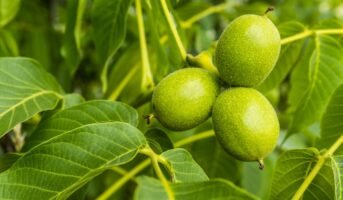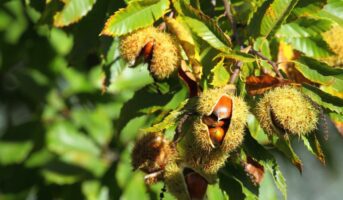Almond trees (scientific name: Prunus dulcis) are the most popular tree nut in the world, as they are used in several traditional recipes across countries, continents, and cuisines. In addition to their subtle earthy aroma and crunchy texture, almonds have numerous health advantages for the heart, brain, skin, hair, and digestive system, making them good breakfast food and a nourishing evening snack. Here’s all you need to know about almonds and how to grow and maintain almond trees.
See also: Trapa: A comprehensive guide about water chestnut plant

Source: Pinterest
See also: All about Prunus Armeniaca
What are almonds?
Almond trees produce fruits called almonds. This species of fruit tree is native to the Middle Eastern countries. It belongs to the same genus as the peach trees. Usually considered nuts, almonds are actually drupes, which are a type of stone fruit featuring a hard shell and an outer hull containing a seed. There are many other kinds of drupes like cherries, olives, and peaches. However, unlike other drupes, almonds are the only drupes with an edible seed. Aside from many culinary uses, almonds also offer a number of health benefits.
know about: sal tree
Almond tree: Key facts
| Common name | Almond |
| Botanical name | Prunus dulcis |
| Mature size | 10 to 40 ft tall |
| Sun exposure | Full sun |
| Soil | Rich, deep, well-drained soil |
| Soil pH | Slightly acidic to neutral to slightly alkaline |
| Bloom time | March |
Almond tree: Physical features
Almond is a deciduous tree ranging in height from four to ten metres with a trunk diameter of up to 30 centimetres. The juvenile twigs are initially green, then purple when exposed to sunshine, and finally grey in their second year. The leaves have a serrated border and a long petiole. The blooms are white to pale pink and have five petals.
The almond’s fruit is a drupe composed of an outer hull and a hard shell containing a seed that is not a genuine nut. This is the edible portion of the almond tree, which is consumed worldwide in the form of raw nuts, roasted or salted snacks, and even processed to produce almond flour and almond oil for culinary and cosmetic applications.
Almond tree: Best climate for growth?
Almond trees are native to the Middle Eastern countries and prefer Mediterranean climates. The ideal climatic conditions for their growth are dry areas that experience hot summers and lots of sunshine. They also like rainy winters but are also very sensitive to frost.
Almond tree: How to grow?
Select a sunny location
Almond trees require extensive space because they can reach heights of 30 feet. 15 to 20 feet away from buildings, electricity wires, and other trees, plant your seedling. To thrive, almond trees require full light and well-draining loam soil.
Prep your sapling
Place the seedling in the hole at the same depth as it was in the container. The container’s topmost soil level should be level with the ground. Be cautious not to damage the taproot.
Dig your hole
Dig a hole deep enough to fit the root system of your plant. If you purchased a bare-root or container-grown tree, dig your hole to the same depth at which it was planted in the nursery, which is typically 18 to 24 inches. To ensure that the hole is sufficiently deep, lay the plant inside and press the taproot firmly against the bottom. If the base of the hole stays above the hole’s rim, do not press it further. The taproot is susceptible to harm from rough handling or cutting.
Plant your own tree
Place the sapling in the centre of the hole and backfill it with dirt that drains nicely. While filling, firmly compact the dirt to remove extra air. Water your sapling with at least one gallon of water immediately. Place a mulch layer around the tree’s base to assist in preserving soil moisture.
Prune small branches
Remove any small branches near the tree’s base. Young trees must be pruned so that their growth is concentrated on the trunk and branches.
Exercise patience
From seedling to fruiting, the almond tree’s dormant stage lasts approximately five years, so do not be frightened if nuts do not appear on your tree for the first few years.
Almond tree: Can you grow it from seed?
While you can grow an almond tree from seeds, the best course of action is to use a sapling instead. This is because like many other nut trees, these trees do not self-pollinate. Successfully growing a nut-bearing almond tree for seeds needs cross-pollination. So, it’s only a viable option if you have the necessary space to plant multiple almond trees.
Almond tree: Care tips
The maintenance of almond trees varies with the season. The growing almond trees should be pruned during the winter or dormant season to promote growth, allow light, and remove any diseased or dead limbs or suckers. Eliminate navel orangeworms by removing trash from the area surrounding the tree and applying dormant oil to kill peach twig borer and mite eggs.

Source: Pinterest
Almond tree: Watering
Maintain a consistent schedule of watering for your tree. Although almond trees can survive the dry heat of summer without any trouble, they nevertheless require consistent irrigation to maintain their health and growth. In the beginning, when your trees are still young, you should water them once a week, missing a week if there is a lot of rain. Avoid letting the soil become too soggy since this can lead to root rot in your trees.
Almond tree: Fertilising
For best results, hold off on fertilising your tree until spring. Small, consistent applications of nitrogen fertiliser throughout the growing season can help young trees thrive, whereas older trees require much less fertiliser. A single application of two pounds of urea after your tree has become established and begun bearing fruit will ensure its continued success.
Almond tree: Pests
The navel orangeworm is the most widespread pest of almond trees. It spends the winter in the nuts left on the tree after the harvest. Gathering all the nuts from the tree will deprive them of their food source and keep them at bay. Peach tree borers, which resemble grubs, attack almond trees by boring into the trunk at ground level. Apply Bacillus thuringiensis spray, or Bt spray, if the growth of your tree has slowed or if you find bug excrement at the tree’s base.
Almond tree: Disease
Bark damage or cuts caused by old, unclean gardening tools are a common way for almond trees to get illnesses. While harvesting, exercise extreme caution to avoid damaging the trees and always use clean instruments.
Almond tree: Uses and benefits
- Enhances the digestive system’s health.
- Works as a supplement to meet nutritional needs during pregnancy.
- Enhances the workings of the brain.
- Helps in moisturising the skin.
- Reduces blood levels of cholesterol.
- Helps maintain a healthy heart.
- Maintains a normal level of blood pressure.
- Suitable for a diabetic diet.
- Provides relief from constipation.
- Promotes weight loss.
- Restores health to damaged skin.
- Provides nutrients that fight ageing.
- Conditions hair and helps prevent hair loss.
Which type of almond tree is best?
There are two types of almond nuts: sweet and bitter. Bitter almond trees are a good option if you are looking to plant these trees purely for ornamental purposes. However, if you want to produce edible almonds, it’s advisable to go for sweet almond trees. The sweet almond cultivars include ‘Mission’, ‘Caramel’, ‘All-in-One’ and ‘Hall’s Hardy’. The ‘All-in-One’ variety of almond trees is self-pollinating, making it the best option to plant in your garden.
Almond tree: Toxicity
Case studies indicate that ingesting six to ten raw bitter almonds is sufficient to poison the average adult.
FAQs:
When should almonds not be consumed?
If you have a nut allergy and experience hives, swelling, and difficulty breathing after eating nuts, you should also avoid almonds.
Why should we not consume almonds with the skin?
The almond's skin contains tannins, making it tough to digest.
Housing News Desk is the news desk of leading online real estate portal, Housing.com. Housing News Desk focuses on a variety of topics such as real estate laws, taxes, current news, property trends, home loans, rentals, décor, green homes, home improvement, etc. The main objective of the news desk, is to cover the real estate sector from the perspective of providing information that is useful to the end-user.
Facebook: https://www.facebook.com/housing.com/
Twitter: https://twitter.com/Housing
Email: [email protected]












